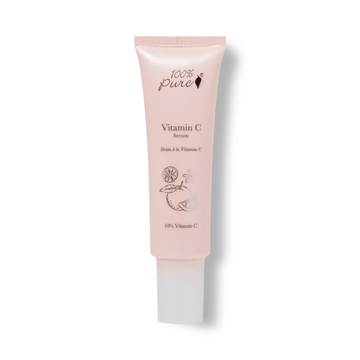Expert advice on why minimal routines often yield better, lasting results
Posted on August 3, 2025 Written by: 100% PURE®
In a world where 15-step skincare routines have dominated social media and bathroom counters have become miniature cosmetics stores, a refreshing shift is taking place. Dermatologists across the country are increasingly advocating for "skinimalism"—the practice of using fewer, more targeted skincare products. But this isn't just another fleeting beauty trend. According to skin experts, this back-to-basics approach is rooted in solid dermatological science and may be the key to achieving the healthy, resilient skin we're all seeking.
The concept challenges everything we've been told about skincare in recent years. More products don't necessarily mean better results. In fact, dermatologists are finding that many of their patients' skin concerns—from persistent acne to chronic sensitivity—stem from overcomplicating their routines. Let's explore why skin experts are embracing minimalism and how you can implement their proven skincare strategies for lasting results.
The Dermatological Case for Less
When dermatologists examine damaged or problematic skin under magnification, they often see signs of a compromised skin barrier. This protective layer, made up of lipids and cells, is your skin's first line of defense against environmental aggressors. According to peer-reviewed dermatological research, one of the primary culprits behind barrier damage is, surprisingly, overzealous skincare routines.
Board-certified dermatologists report that they're seeing an increase in patients with "cosmetic intolerance syndrome"—a condition where skin becomes reactive to multiple products due to overuse. The skin becomes trapped in a cycle of irritation and attempted repair, never quite achieving balance. This phenomenon has led many skin experts to reconsider the "more is more" approach that has dominated skincare culture.
Recent studies published in dermatological journals support what practitioners are seeing in their clinics. Research shows that the skin's natural processes—including cell turnover, lipid production, and microbiome balance—can be disrupted by excessive product use. When we layer multiple active ingredients, we're not giving our skin time to respond to each one appropriately. Instead, we may be creating a chaotic environment where the skin is constantly reacting rather than thriving.
The Science of Skin Simplicity
To understand why skinimalism works, it's essential to understand how skin functions. Dermatologists explain that healthy skin is remarkably self-sufficient. It produces its own moisturizing factors, regulates oil production, and maintains a delicate pH balance. When we support these natural processes rather than override them, skin often responds beautifully.
The skin barrier operates best at a pH between 4.5 and 5.5. Each product we apply can potentially shift this pH, and using multiple products in succession can create dramatic fluctuations. Dermatologists note that maintaining a stable pH environment allows the skin's beneficial bacteria to thrive while keeping problematic bacteria in check. This is why many skin experts now recommend using fewer products that work in harmony with skin's natural pH.
Furthermore, dermatological research has shown that giving skin time between product applications allows for better absorption and utilization of active ingredients. When we rush through a multi-step routine, we may be diluting the effectiveness of each product and potentially creating unwanted interactions between ingredients.
What Dermatologists Actually Use
One of the most telling endorsements of skinimalism comes from looking at what dermatologists use on their own skin. Surveys of dermatological professionals reveal remarkably consistent patterns in their personal routines. The vast majority stick to basic regimens featuring just a handful of proven ingredients.
The typical dermatologist skincare routine includes:
- A gentle, pH-balanced cleanser
- A targeted serum with proven actives
- A moisturizer appropriate for their skin type
- Broad-spectrum sunscreen
That's it. No essence, no multiple serums, no elaborate layering techniques. These skin experts understand that consistency with a few quality products yields better results than constantly switching between numerous formulations.

The Power of Proven Ingredients
When dermatologists do recommend products, they focus on ingredients with substantial scientific backing. This is where targeted, well-formulated products shine. Take vitamin C, for example. Dermatological studies have consistently shown its benefits for brightening, collagen production, and antioxidant protection. A quality formulation like the 100% PURE Vitamin C Serum delivers these benefits without unnecessary additives that could compromise its effectiveness or irritate skin.
Similarly, dermatologists frequently recommend green tea extract for its anti-inflammatory properties. The 100% PURE Green Tea EGCG Concentrate Serum exemplifies how a single, potent ingredient can address multiple skin concerns. EGCG, the primary antioxidant in green tea, has been shown in clinical studies to reduce inflammation, protect against UV damage, and even help regulate sebum production.
For evening routines, dermatologists often suggest incorporating multiple antioxidants that work synergistically. The 100% PURE Multi-Vitamin + Antioxidants PM Serum follows this principle, combining vitamins and antioxidants in a way that enhances their individual benefits while maintaining the simplicity of a single application.
The Retinoid Question: Quality Over Quantity
One area where dermatologists see particular benefit in the minimal approach is with retinoids and retinoid alternatives. These powerful ingredients require careful integration into a routine, and surrounding them with too many other actives can lead to irritation. Many dermatologists now recommend bakuchiol as a gentler alternative that provides similar benefits without the adjustment period.
The 100% PURE Bakuchiol Moisturizer represents this evolved approach—delivering retinoid-like benefits in a moisturizing base that simplifies routines. Rather than requiring separate applications of treatment and moisturizer, this type of formulation addresses multiple needs efficiently. Dermatologists appreciate when patients can achieve their goals with fewer steps, as it increases compliance and reduces the risk of irritation.
Addressing Complex Concerns Simply
Critics of skinimalism often argue that complex skin concerns require complex solutions. However, dermatologists counter that even challenging conditions often respond better to simplified approaches. Take hyperpigmentation, for example. Rather than attacking it with multiple lightening agents, acids, and exfoliants, many dermatologists now recommend a focused approach: consistent use of sunscreen, a single brightening ingredient like vitamin C, and patience.
For mature skin, the temptation to use every anti-aging ingredient available is strong. Yet dermatological research suggests that a few well-chosen ingredients often outperform a cabinet full of products. Rich, reparative formulations like the 100% PURE Restorative Sea Culture Extra Riche Créme can deliver multiple benefits—hydration, nourishment, and barrier repair—without requiring numerous layered products.
The Dermatologist's Guide to Building a Minimal Routine
Based on dermatological best practices, here's how to build an effective minimal routine:
Morning Routine
- Cleanse: Use lukewarm water and a gentle cleanser only if necessary (many dermatologists recommend water-only morning cleansing for dry or normal skin)
- Treat: Apply a single serum targeting your primary concern
- Protect: Use a broad-spectrum SPF 30 or higher
Evening Routine
- Cleanse: Remove sunscreen and daily buildup with a gentle cleanser
- Treat: Apply your active treatment (retinoid, bakuchiol, or antioxidant serum)
- Moisturize: Use a product appropriate for your skin type
The Weekly Addition
Once or twice per week, incorporate gentle exfoliation or a treatment mask, but never on the same day as other active treatments.
Common Mistakes Dermatologists See
Even when attempting skinimalism, patients often make errors that dermatologists frequently correct:
Mistake 1: Switching Products Too Quickly
Dermatologists emphasize that skin needs at least 6-8 weeks to show results from a new product. Constantly switching prevents you from seeing what actually works.
Mistake 2: Using Multiple Actives Together
Combining vitamin C, retinoids, and acids might seem efficient, but dermatologists warn this often leads to irritation without additional benefits.
Mistake 3: Ignoring Product pH
Using products with vastly different pH levels in succession can disrupt skin's acid mantle. Dermatologists recommend checking product pH when possible.
Mistake 4: Overcomplicating "Simple"
Some interpret minimal skincare as using single-ingredient products exclusively. Dermatologists clarify that well-formulated products with multiple complementary ingredients can still be part of a minimal routine.
The Psychological Benefits
Interestingly, dermatologists report that patients who adopt skinimalist routines often experience psychological benefits alongside skin improvements. The reduced decision fatigue, lower financial burden, and decreased anxiety about "doing it right" contribute to overall well-being. This mind-skin connection is increasingly recognized in dermatological practice.
Patients report feeling more confident when they understand exactly what they're putting on their skin and why. This empowerment often leads to better compliance and, consequently, better results. Dermatologists note that patients who stick to simple routines for extended periods typically achieve more significant improvements than those constantly chasing the next miracle product.

Special Considerations for Different Skin Types
While skinimalism benefits all skin types, dermatologists tailor their recommendations based on individual needs:
For Oily/Acne-Prone Skin
Focus on gentle cleansing, lightweight hydration, and single active treatments. Avoid the temptation to use multiple acne-fighting ingredients simultaneously.
For Dry/Sensitive Skin
Prioritize barrier repair and hydration. Limit active ingredients to one at a time and introduce them slowly.
For Combination Skin
Resist the urge to use different products on different face zones. Find balanced products that work for your entire face.
For Mature Skin
Quality over quantity is crucial. Invest in well-formulated products with proven anti-aging ingredients rather than trying every new anti-aging launch.
The Environmental and Economic Benefits
Dermatologists increasingly consider the broader impact of skincare recommendations. Skinimalism aligns with sustainable practices by reducing packaging waste and chemical runoff. From an economic standpoint, investing in fewer, higher-quality products often costs less than maintaining an extensive routine with mediocre formulations.
This approach also reduces the likelihood of product waste. Dermatologists report that many patients have drawers full of partially used products that didn't work or caused reactions. By committing to a minimal routine, you're more likely to use products completely and can better assess their effectiveness.
When to Seek Professional Guidance
While skinimalism works well for many, dermatologists emphasize that certain conditions require professional intervention. Persistent acne, rosacea, melasma, and other chronic skin conditions may need prescription treatments. However, even in these cases, dermatologists typically recommend keeping the rest of the routine minimal to avoid interference with medical treatments.
Signs you should consult a dermatologist:
- Persistent skin issues despite consistent routine for 8-12 weeks
- Sudden changes in skin behavior
- Painful or spreading skin conditions
- Concerns about skin cancer or suspicious moles
The Future of Skincare
Leading dermatologists predict that skinimalism represents the future of skincare rather than a passing trend. As our understanding of skin biology deepens, the focus shifts from correcting problems to supporting skin's natural functions. This preventative, supportive approach aligns perfectly with minimal routines.
Research continues to support the benefits of working with skin rather than against it. Future innovations in skincare will likely focus on creating more effective, multifunctional products rather than encouraging extensive routines. Dermatologists are optimistic that this shift will lead to healthier skin outcomes across all demographics.
Conclusion: Trust the Experts
When board-certified dermatologists—the professionals who understand skin at the cellular level—advocate for minimal routines, it's worth paying attention. Their endorsement of skinimalism isn't based on trends or marketing but on scientific understanding of how skin functions best.
The message from dermatologists is clear: your skin doesn't need a dozen products to be healthy. It needs the right products, used consistently, that support its natural processes. By embracing skinimalism, you're not just simplifying your routine—you're aligning with proven skincare principles that dermatologists have long understood.
Whether you're dealing with sensitivity, aging, acne, or simply want to maintain healthy skin, the path forward may be simpler than you think. Start with the basics—cleanse, treat, protect—and build from there only if necessary. Your skin, wallet, and bathroom counter will thank you for embracing this dermatologist-approved approach to skincare.
- Tags: August-2025
We carefully hand-select products based on strict purity standards, and only recommend products we feel meet this criteria. 100% PURE™ may earn a small commission for products purchased through affiliate links.
The information in this article is for educational use, and not intended to substitute professional medical advice, diagnosis, or treatment and should not be used as such.

















